LST5CCL Company & Commercial Law: Analyzing Partnership and Liability
VerifiedAdded on 2023/06/11
|10
|3191
|155
Case Study
AI Summary
This case study examines several legal issues arising from a business venture involving Julio, Carolyn, Trisha, and Sarah. It first determines that Julio, Carolyn, and Trisha formed a partnership, while Sarah, who provided a loan, is not a partner. The study then analyzes the implications of a unilateral mistake made by Julio in a contract with a client, X, concluding that the partnership is liable for the damages suffered by X due to Julio's actions, referencing Section 5 of the Partnership Act and relevant case law like Polkinghorne v Holland. Finally, it assesses the liability of Julio and his partners for negligent advice given to X that resulted in damages to a third party, Y, applying principles from cases like Steel and another v NRAM Ltd and Caparo Industries v Dickman to determine that liability for negligent misstatement requires foreseeability and reasonable reliance. Desklib offers similar solved assignments and resources for students.
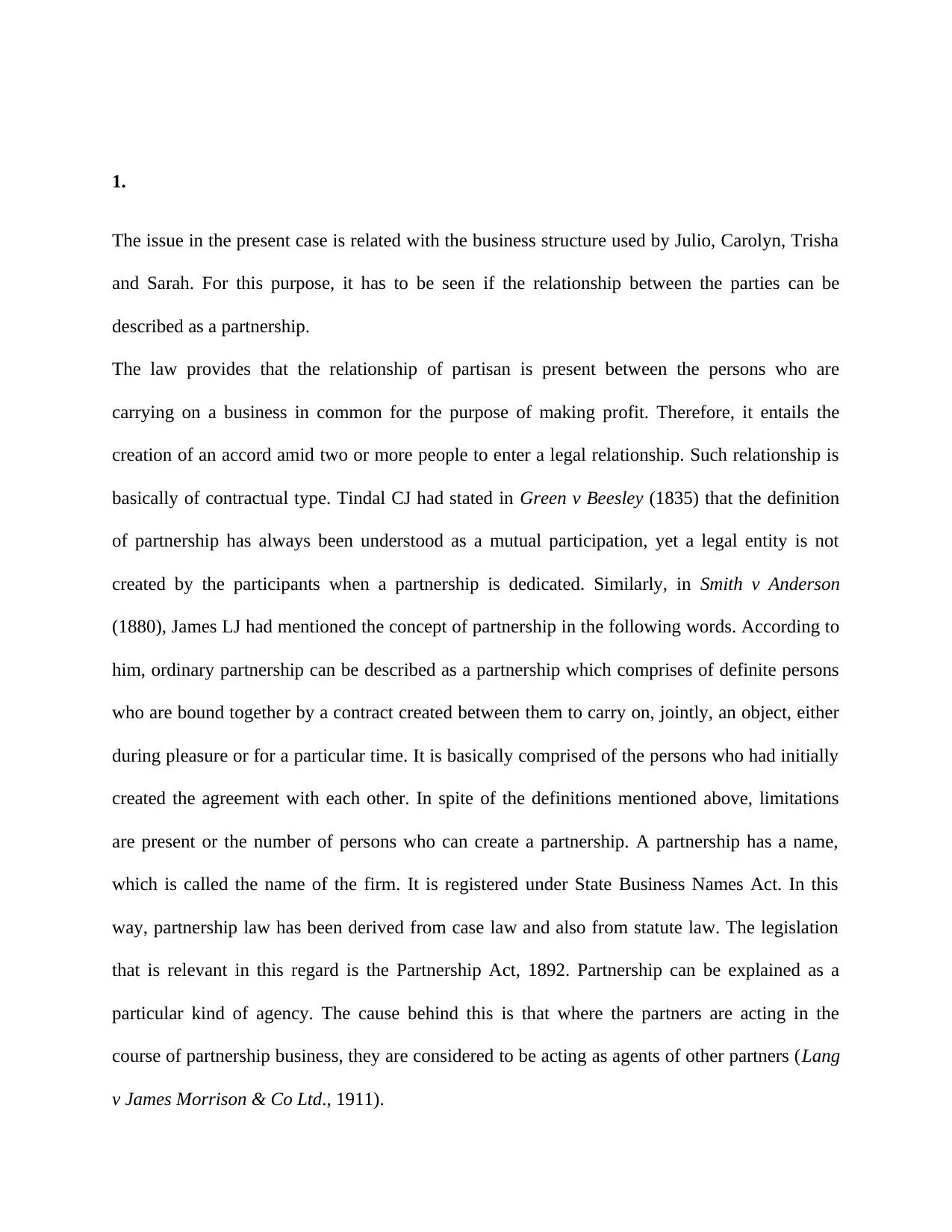
1.
The issue in the present case is related with the business structure used by Julio, Carolyn, Trisha
and Sarah. For this purpose, it has to be seen if the relationship between the parties can be
described as a partnership.
The law provides that the relationship of partisan is present between the persons who are
carrying on a business in common for the purpose of making profit. Therefore, it entails the
creation of an accord amid two or more people to enter a legal relationship. Such relationship is
basically of contractual type. Tindal CJ had stated in Green v Beesley (1835) that the definition
of partnership has always been understood as a mutual participation, yet a legal entity is not
created by the participants when a partnership is dedicated. Similarly, in Smith v Anderson
(1880), James LJ had mentioned the concept of partnership in the following words. According to
him, ordinary partnership can be described as a partnership which comprises of definite persons
who are bound together by a contract created between them to carry on, jointly, an object, either
during pleasure or for a particular time. It is basically comprised of the persons who had initially
created the agreement with each other. In spite of the definitions mentioned above, limitations
are present or the number of persons who can create a partnership. A partnership has a name,
which is called the name of the firm. It is registered under State Business Names Act. In this
way, partnership law has been derived from case law and also from statute law. The legislation
that is relevant in this regard is the Partnership Act, 1892. Partnership can be explained as a
particular kind of agency. The cause behind this is that where the partners are acting in the
course of partnership business, they are considered to be acting as agents of other partners (Lang
v James Morrison & Co Ltd., 1911).
The issue in the present case is related with the business structure used by Julio, Carolyn, Trisha
and Sarah. For this purpose, it has to be seen if the relationship between the parties can be
described as a partnership.
The law provides that the relationship of partisan is present between the persons who are
carrying on a business in common for the purpose of making profit. Therefore, it entails the
creation of an accord amid two or more people to enter a legal relationship. Such relationship is
basically of contractual type. Tindal CJ had stated in Green v Beesley (1835) that the definition
of partnership has always been understood as a mutual participation, yet a legal entity is not
created by the participants when a partnership is dedicated. Similarly, in Smith v Anderson
(1880), James LJ had mentioned the concept of partnership in the following words. According to
him, ordinary partnership can be described as a partnership which comprises of definite persons
who are bound together by a contract created between them to carry on, jointly, an object, either
during pleasure or for a particular time. It is basically comprised of the persons who had initially
created the agreement with each other. In spite of the definitions mentioned above, limitations
are present or the number of persons who can create a partnership. A partnership has a name,
which is called the name of the firm. It is registered under State Business Names Act. In this
way, partnership law has been derived from case law and also from statute law. The legislation
that is relevant in this regard is the Partnership Act, 1892. Partnership can be explained as a
particular kind of agency. The cause behind this is that where the partners are acting in the
course of partnership business, they are considered to be acting as agents of other partners (Lang
v James Morrison & Co Ltd., 1911).
Paraphrase This Document
Need a fresh take? Get an instant paraphrase of this document with our AI Paraphraser
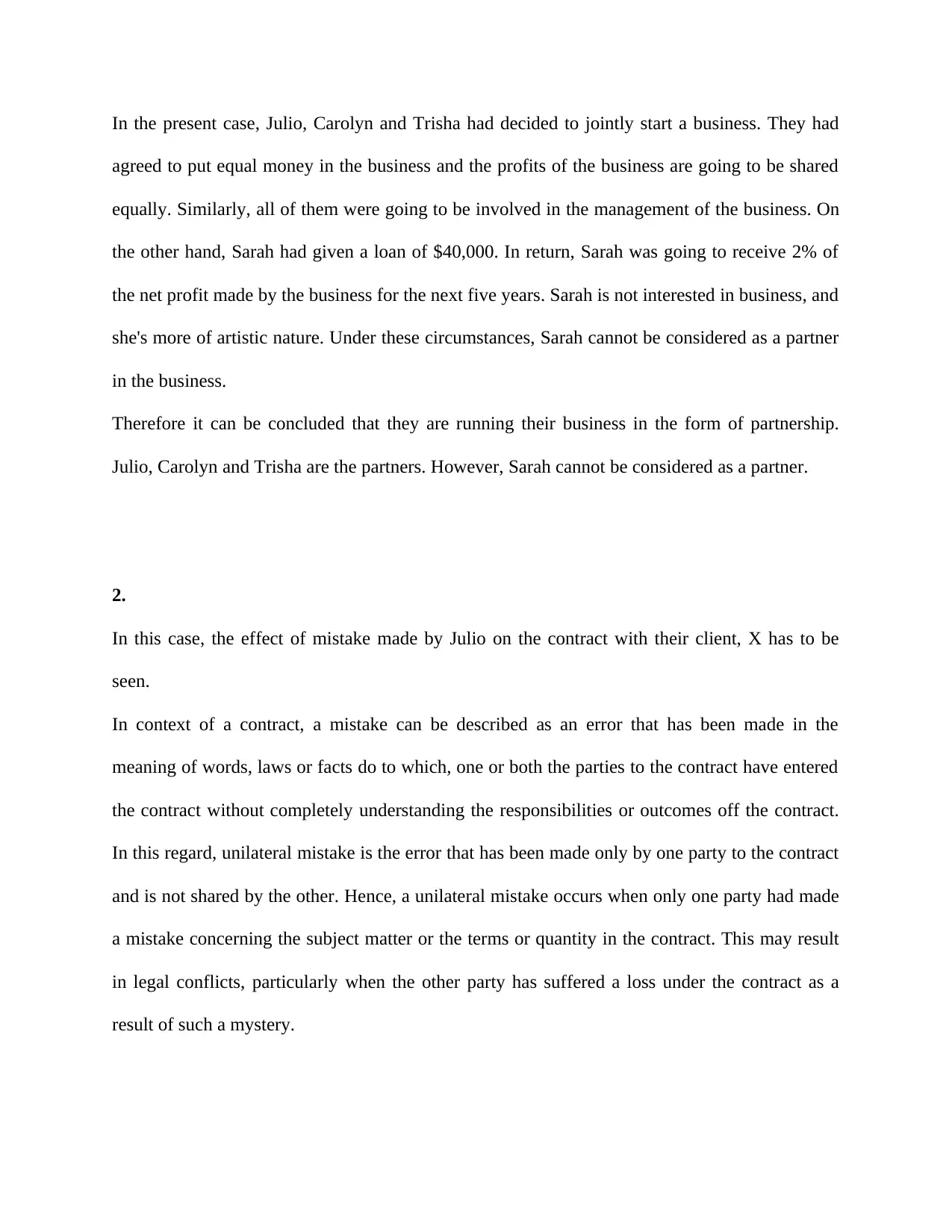
In the present case, Julio, Carolyn and Trisha had decided to jointly start a business. They had
agreed to put equal money in the business and the profits of the business are going to be shared
equally. Similarly, all of them were going to be involved in the management of the business. On
the other hand, Sarah had given a loan of $40,000. In return, Sarah was going to receive 2% of
the net profit made by the business for the next five years. Sarah is not interested in business, and
she's more of artistic nature. Under these circumstances, Sarah cannot be considered as a partner
in the business.
Therefore it can be concluded that they are running their business in the form of partnership.
Julio, Carolyn and Trisha are the partners. However, Sarah cannot be considered as a partner.
2.
In this case, the effect of mistake made by Julio on the contract with their client, X has to be
seen.
In context of a contract, a mistake can be described as an error that has been made in the
meaning of words, laws or facts do to which, one or both the parties to the contract have entered
the contract without completely understanding the responsibilities or outcomes off the contract.
In this regard, unilateral mistake is the error that has been made only by one party to the contract
and is not shared by the other. Hence, a unilateral mistake occurs when only one party had made
a mistake concerning the subject matter or the terms or quantity in the contract. This may result
in legal conflicts, particularly when the other party has suffered a loss under the contract as a
result of such a mystery.
agreed to put equal money in the business and the profits of the business are going to be shared
equally. Similarly, all of them were going to be involved in the management of the business. On
the other hand, Sarah had given a loan of $40,000. In return, Sarah was going to receive 2% of
the net profit made by the business for the next five years. Sarah is not interested in business, and
she's more of artistic nature. Under these circumstances, Sarah cannot be considered as a partner
in the business.
Therefore it can be concluded that they are running their business in the form of partnership.
Julio, Carolyn and Trisha are the partners. However, Sarah cannot be considered as a partner.
2.
In this case, the effect of mistake made by Julio on the contract with their client, X has to be
seen.
In context of a contract, a mistake can be described as an error that has been made in the
meaning of words, laws or facts do to which, one or both the parties to the contract have entered
the contract without completely understanding the responsibilities or outcomes off the contract.
In this regard, unilateral mistake is the error that has been made only by one party to the contract
and is not shared by the other. Hence, a unilateral mistake occurs when only one party had made
a mistake concerning the subject matter or the terms or quantity in the contract. This may result
in legal conflicts, particularly when the other party has suffered a loss under the contract as a
result of such a mystery.
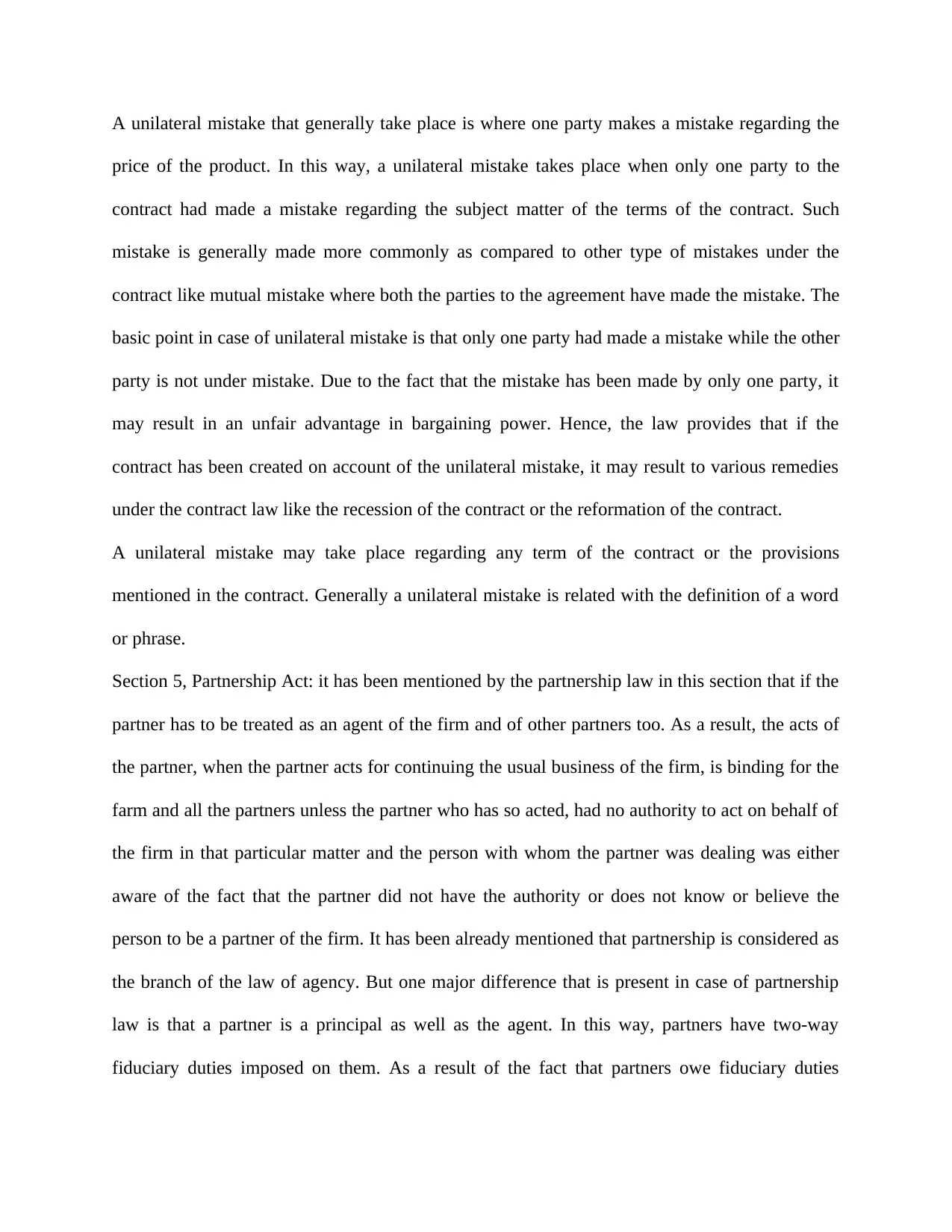
A unilateral mistake that generally take place is where one party makes a mistake regarding the
price of the product. In this way, a unilateral mistake takes place when only one party to the
contract had made a mistake regarding the subject matter of the terms of the contract. Such
mistake is generally made more commonly as compared to other type of mistakes under the
contract like mutual mistake where both the parties to the agreement have made the mistake. The
basic point in case of unilateral mistake is that only one party had made a mistake while the other
party is not under mistake. Due to the fact that the mistake has been made by only one party, it
may result in an unfair advantage in bargaining power. Hence, the law provides that if the
contract has been created on account of the unilateral mistake, it may result to various remedies
under the contract law like the recession of the contract or the reformation of the contract.
A unilateral mistake may take place regarding any term of the contract or the provisions
mentioned in the contract. Generally a unilateral mistake is related with the definition of a word
or phrase.
Section 5, Partnership Act: it has been mentioned by the partnership law in this section that if the
partner has to be treated as an agent of the firm and of other partners too. As a result, the acts of
the partner, when the partner acts for continuing the usual business of the firm, is binding for the
farm and all the partners unless the partner who has so acted, had no authority to act on behalf of
the firm in that particular matter and the person with whom the partner was dealing was either
aware of the fact that the partner did not have the authority or does not know or believe the
person to be a partner of the firm. It has been already mentioned that partnership is considered as
the branch of the law of agency. But one major difference that is present in case of partnership
law is that a partner is a principal as well as the agent. In this way, partners have two-way
fiduciary duties imposed on them. As a result of the fact that partners owe fiduciary duties
price of the product. In this way, a unilateral mistake takes place when only one party to the
contract had made a mistake regarding the subject matter of the terms of the contract. Such
mistake is generally made more commonly as compared to other type of mistakes under the
contract like mutual mistake where both the parties to the agreement have made the mistake. The
basic point in case of unilateral mistake is that only one party had made a mistake while the other
party is not under mistake. Due to the fact that the mistake has been made by only one party, it
may result in an unfair advantage in bargaining power. Hence, the law provides that if the
contract has been created on account of the unilateral mistake, it may result to various remedies
under the contract law like the recession of the contract or the reformation of the contract.
A unilateral mistake may take place regarding any term of the contract or the provisions
mentioned in the contract. Generally a unilateral mistake is related with the definition of a word
or phrase.
Section 5, Partnership Act: it has been mentioned by the partnership law in this section that if the
partner has to be treated as an agent of the firm and of other partners too. As a result, the acts of
the partner, when the partner acts for continuing the usual business of the firm, is binding for the
farm and all the partners unless the partner who has so acted, had no authority to act on behalf of
the firm in that particular matter and the person with whom the partner was dealing was either
aware of the fact that the partner did not have the authority or does not know or believe the
person to be a partner of the firm. It has been already mentioned that partnership is considered as
the branch of the law of agency. But one major difference that is present in case of partnership
law is that a partner is a principal as well as the agent. In this way, partners have two-way
fiduciary duties imposed on them. As a result of the fact that partners owe fiduciary duties
⊘ This is a preview!⊘
Do you want full access?
Subscribe today to unlock all pages.

Trusted by 1+ million students worldwide
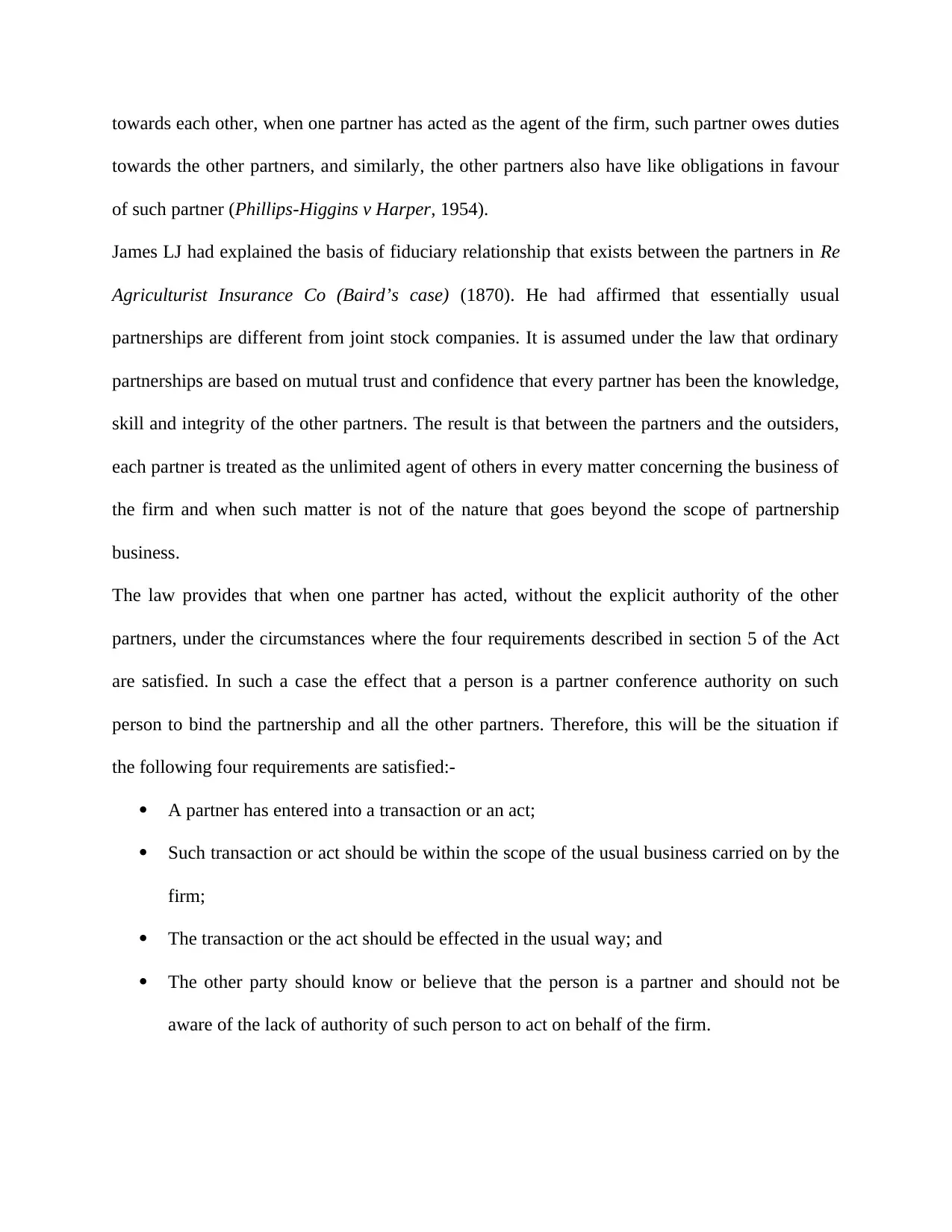
towards each other, when one partner has acted as the agent of the firm, such partner owes duties
towards the other partners, and similarly, the other partners also have like obligations in favour
of such partner (Phillips-Higgins v Harper, 1954).
James LJ had explained the basis of fiduciary relationship that exists between the partners in Re
Agriculturist Insurance Co (Baird’s case) (1870). He had affirmed that essentially usual
partnerships are different from joint stock companies. It is assumed under the law that ordinary
partnerships are based on mutual trust and confidence that every partner has been the knowledge,
skill and integrity of the other partners. The result is that between the partners and the outsiders,
each partner is treated as the unlimited agent of others in every matter concerning the business of
the firm and when such matter is not of the nature that goes beyond the scope of partnership
business.
The law provides that when one partner has acted, without the explicit authority of the other
partners, under the circumstances where the four requirements described in section 5 of the Act
are satisfied. In such a case the effect that a person is a partner conference authority on such
person to bind the partnership and all the other partners. Therefore, this will be the situation if
the following four requirements are satisfied:-
A partner has entered into a transaction or an act;
Such transaction or act should be within the scope of the usual business carried on by the
firm;
The transaction or the act should be effected in the usual way; and
The other party should know or believe that the person is a partner and should not be
aware of the lack of authority of such person to act on behalf of the firm.
towards the other partners, and similarly, the other partners also have like obligations in favour
of such partner (Phillips-Higgins v Harper, 1954).
James LJ had explained the basis of fiduciary relationship that exists between the partners in Re
Agriculturist Insurance Co (Baird’s case) (1870). He had affirmed that essentially usual
partnerships are different from joint stock companies. It is assumed under the law that ordinary
partnerships are based on mutual trust and confidence that every partner has been the knowledge,
skill and integrity of the other partners. The result is that between the partners and the outsiders,
each partner is treated as the unlimited agent of others in every matter concerning the business of
the firm and when such matter is not of the nature that goes beyond the scope of partnership
business.
The law provides that when one partner has acted, without the explicit authority of the other
partners, under the circumstances where the four requirements described in section 5 of the Act
are satisfied. In such a case the effect that a person is a partner conference authority on such
person to bind the partnership and all the other partners. Therefore, this will be the situation if
the following four requirements are satisfied:-
A partner has entered into a transaction or an act;
Such transaction or act should be within the scope of the usual business carried on by the
firm;
The transaction or the act should be effected in the usual way; and
The other party should know or believe that the person is a partner and should not be
aware of the lack of authority of such person to act on behalf of the firm.
Paraphrase This Document
Need a fresh take? Get an instant paraphrase of this document with our AI Paraphraser
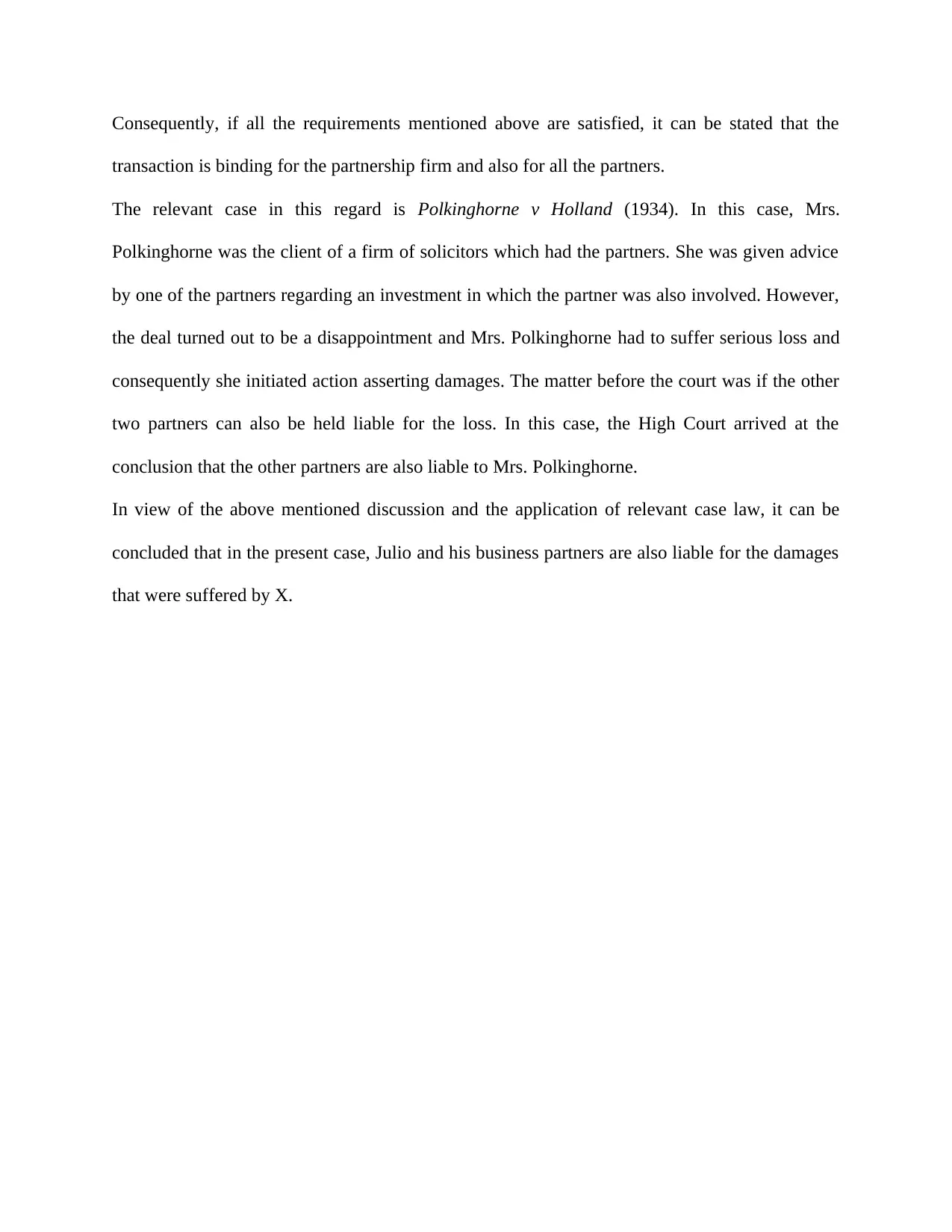
Consequently, if all the requirements mentioned above are satisfied, it can be stated that the
transaction is binding for the partnership firm and also for all the partners.
The relevant case in this regard is Polkinghorne v Holland (1934). In this case, Mrs.
Polkinghorne was the client of a firm of solicitors which had the partners. She was given advice
by one of the partners regarding an investment in which the partner was also involved. However,
the deal turned out to be a disappointment and Mrs. Polkinghorne had to suffer serious loss and
consequently she initiated action asserting damages. The matter before the court was if the other
two partners can also be held liable for the loss. In this case, the High Court arrived at the
conclusion that the other partners are also liable to Mrs. Polkinghorne.
In view of the above mentioned discussion and the application of relevant case law, it can be
concluded that in the present case, Julio and his business partners are also liable for the damages
that were suffered by X.
transaction is binding for the partnership firm and also for all the partners.
The relevant case in this regard is Polkinghorne v Holland (1934). In this case, Mrs.
Polkinghorne was the client of a firm of solicitors which had the partners. She was given advice
by one of the partners regarding an investment in which the partner was also involved. However,
the deal turned out to be a disappointment and Mrs. Polkinghorne had to suffer serious loss and
consequently she initiated action asserting damages. The matter before the court was if the other
two partners can also be held liable for the loss. In this case, the High Court arrived at the
conclusion that the other partners are also liable to Mrs. Polkinghorne.
In view of the above mentioned discussion and the application of relevant case law, it can be
concluded that in the present case, Julio and his business partners are also liable for the damages
that were suffered by X.
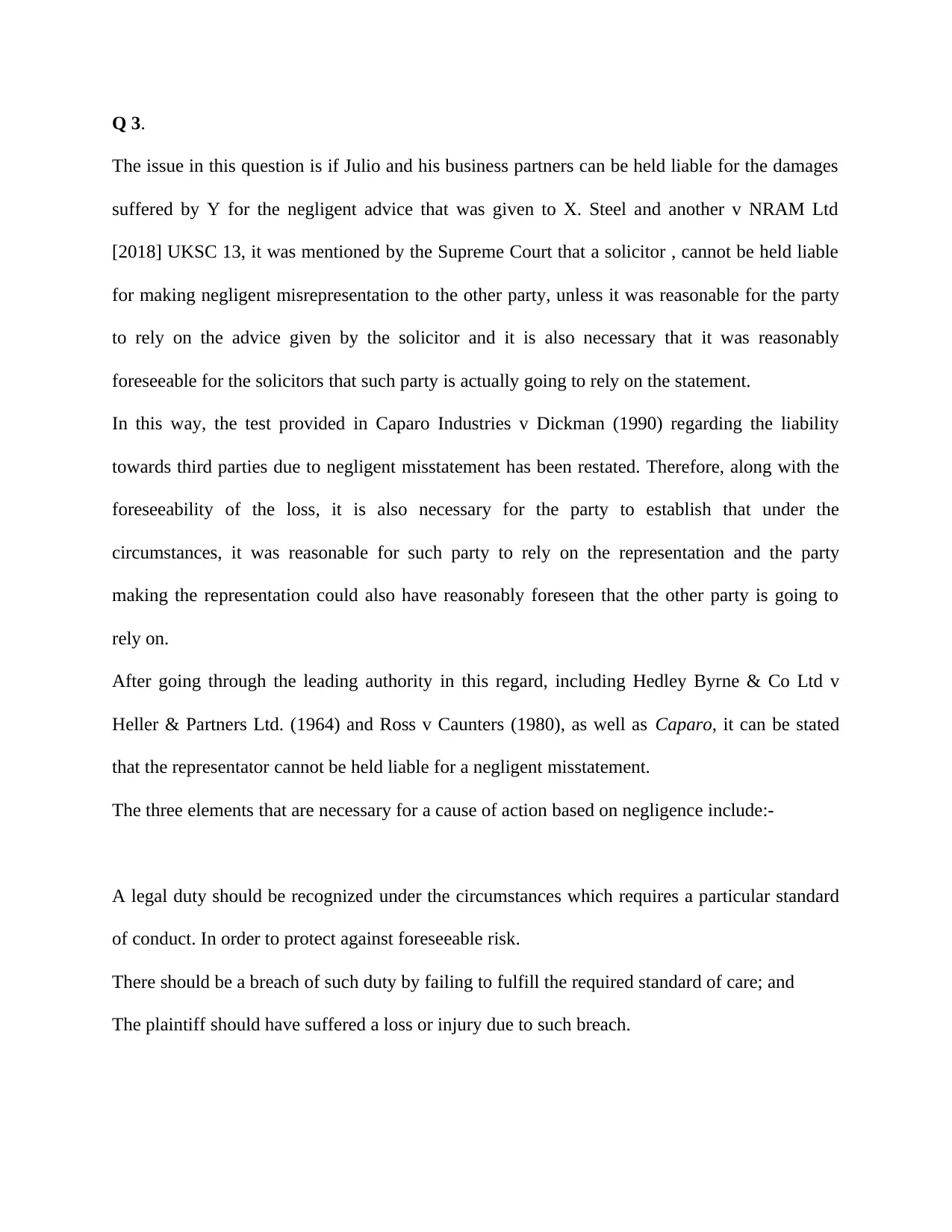
Q 3.
The issue in this question is if Julio and his business partners can be held liable for the damages
suffered by Y for the negligent advice that was given to X. Steel and another v NRAM Ltd
[2018] UKSC 13, it was mentioned by the Supreme Court that a solicitor , cannot be held liable
for making negligent misrepresentation to the other party, unless it was reasonable for the party
to rely on the advice given by the solicitor and it is also necessary that it was reasonably
foreseeable for the solicitors that such party is actually going to rely on the statement.
In this way, the test provided in Caparo Industries v Dickman (1990) regarding the liability
towards third parties due to negligent misstatement has been restated. Therefore, along with the
foreseeability of the loss, it is also necessary for the party to establish that under the
circumstances, it was reasonable for such party to rely on the representation and the party
making the representation could also have reasonably foreseen that the other party is going to
rely on.
After going through the leading authority in this regard, including Hedley Byrne & Co Ltd v
Heller & Partners Ltd. (1964) and Ross v Caunters (1980), as well as Caparo, it can be stated
that the representator cannot be held liable for a negligent misstatement.
The three elements that are necessary for a cause of action based on negligence include:-
A legal duty should be recognized under the circumstances which requires a particular standard
of conduct. In order to protect against foreseeable risk.
There should be a breach of such duty by failing to fulfill the required standard of care; and
The plaintiff should have suffered a loss or injury due to such breach.
The issue in this question is if Julio and his business partners can be held liable for the damages
suffered by Y for the negligent advice that was given to X. Steel and another v NRAM Ltd
[2018] UKSC 13, it was mentioned by the Supreme Court that a solicitor , cannot be held liable
for making negligent misrepresentation to the other party, unless it was reasonable for the party
to rely on the advice given by the solicitor and it is also necessary that it was reasonably
foreseeable for the solicitors that such party is actually going to rely on the statement.
In this way, the test provided in Caparo Industries v Dickman (1990) regarding the liability
towards third parties due to negligent misstatement has been restated. Therefore, along with the
foreseeability of the loss, it is also necessary for the party to establish that under the
circumstances, it was reasonable for such party to rely on the representation and the party
making the representation could also have reasonably foreseen that the other party is going to
rely on.
After going through the leading authority in this regard, including Hedley Byrne & Co Ltd v
Heller & Partners Ltd. (1964) and Ross v Caunters (1980), as well as Caparo, it can be stated
that the representator cannot be held liable for a negligent misstatement.
The three elements that are necessary for a cause of action based on negligence include:-
A legal duty should be recognized under the circumstances which requires a particular standard
of conduct. In order to protect against foreseeable risk.
There should be a breach of such duty by failing to fulfill the required standard of care; and
The plaintiff should have suffered a loss or injury due to such breach.
⊘ This is a preview!⊘
Do you want full access?
Subscribe today to unlock all pages.

Trusted by 1+ million students worldwide
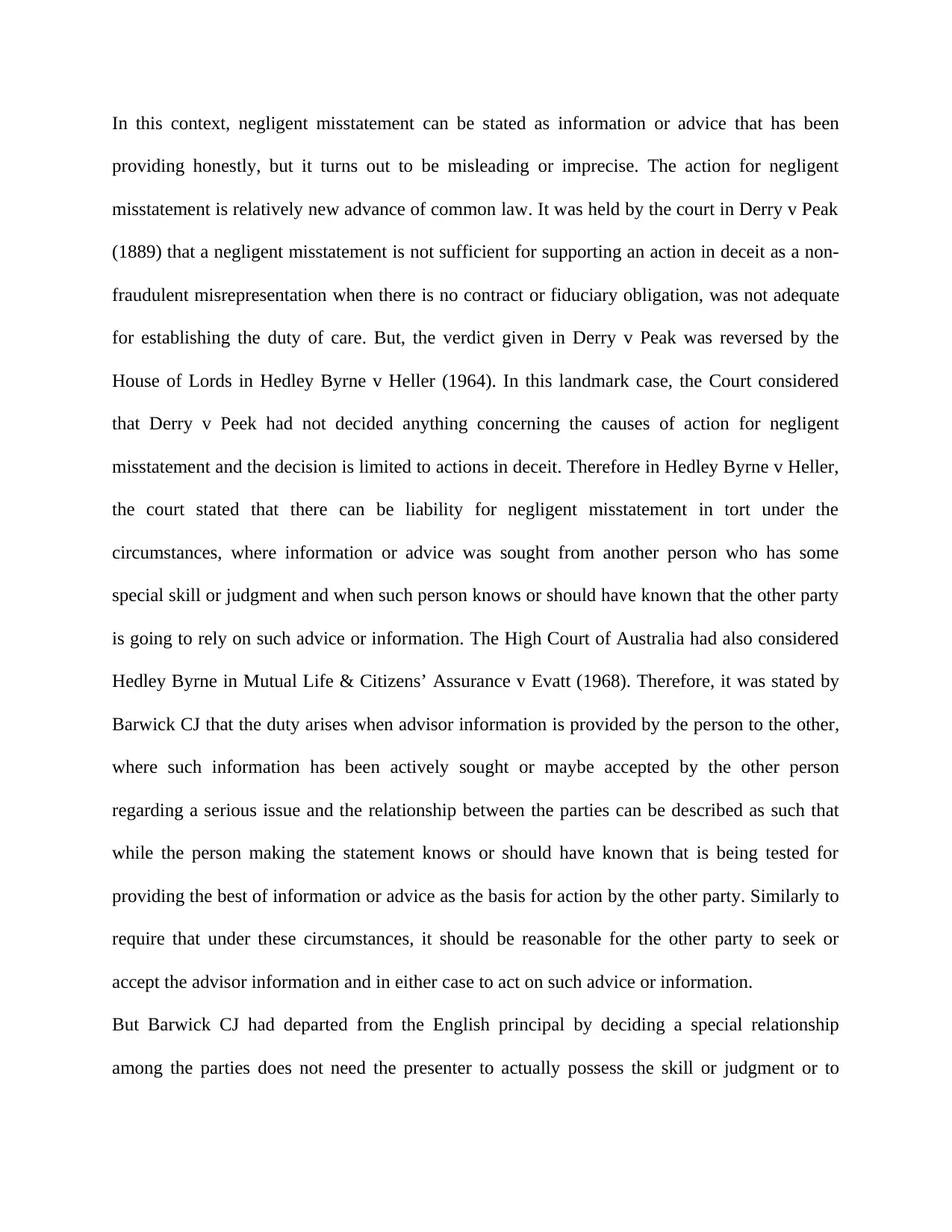
In this context, negligent misstatement can be stated as information or advice that has been
providing honestly, but it turns out to be misleading or imprecise. The action for negligent
misstatement is relatively new advance of common law. It was held by the court in Derry v Peak
(1889) that a negligent misstatement is not sufficient for supporting an action in deceit as a non-
fraudulent misrepresentation when there is no contract or fiduciary obligation, was not adequate
for establishing the duty of care. But, the verdict given in Derry v Peak was reversed by the
House of Lords in Hedley Byrne v Heller (1964). In this landmark case, the Court considered
that Derry v Peek had not decided anything concerning the causes of action for negligent
misstatement and the decision is limited to actions in deceit. Therefore in Hedley Byrne v Heller,
the court stated that there can be liability for negligent misstatement in tort under the
circumstances, where information or advice was sought from another person who has some
special skill or judgment and when such person knows or should have known that the other party
is going to rely on such advice or information. The High Court of Australia had also considered
Hedley Byrne in Mutual Life & Citizens’ Assurance v Evatt (1968). Therefore, it was stated by
Barwick CJ that the duty arises when advisor information is provided by the person to the other,
where such information has been actively sought or maybe accepted by the other person
regarding a serious issue and the relationship between the parties can be described as such that
while the person making the statement knows or should have known that is being tested for
providing the best of information or advice as the basis for action by the other party. Similarly to
require that under these circumstances, it should be reasonable for the other party to seek or
accept the advisor information and in either case to act on such advice or information.
But Barwick CJ had departed from the English principal by deciding a special relationship
among the parties does not need the presenter to actually possess the skill or judgment or to
providing honestly, but it turns out to be misleading or imprecise. The action for negligent
misstatement is relatively new advance of common law. It was held by the court in Derry v Peak
(1889) that a negligent misstatement is not sufficient for supporting an action in deceit as a non-
fraudulent misrepresentation when there is no contract or fiduciary obligation, was not adequate
for establishing the duty of care. But, the verdict given in Derry v Peak was reversed by the
House of Lords in Hedley Byrne v Heller (1964). In this landmark case, the Court considered
that Derry v Peek had not decided anything concerning the causes of action for negligent
misstatement and the decision is limited to actions in deceit. Therefore in Hedley Byrne v Heller,
the court stated that there can be liability for negligent misstatement in tort under the
circumstances, where information or advice was sought from another person who has some
special skill or judgment and when such person knows or should have known that the other party
is going to rely on such advice or information. The High Court of Australia had also considered
Hedley Byrne in Mutual Life & Citizens’ Assurance v Evatt (1968). Therefore, it was stated by
Barwick CJ that the duty arises when advisor information is provided by the person to the other,
where such information has been actively sought or maybe accepted by the other person
regarding a serious issue and the relationship between the parties can be described as such that
while the person making the statement knows or should have known that is being tested for
providing the best of information or advice as the basis for action by the other party. Similarly to
require that under these circumstances, it should be reasonable for the other party to seek or
accept the advisor information and in either case to act on such advice or information.
But Barwick CJ had departed from the English principal by deciding a special relationship
among the parties does not need the presenter to actually possess the skill or judgment or to
Paraphrase This Document
Need a fresh take? Get an instant paraphrase of this document with our AI Paraphraser
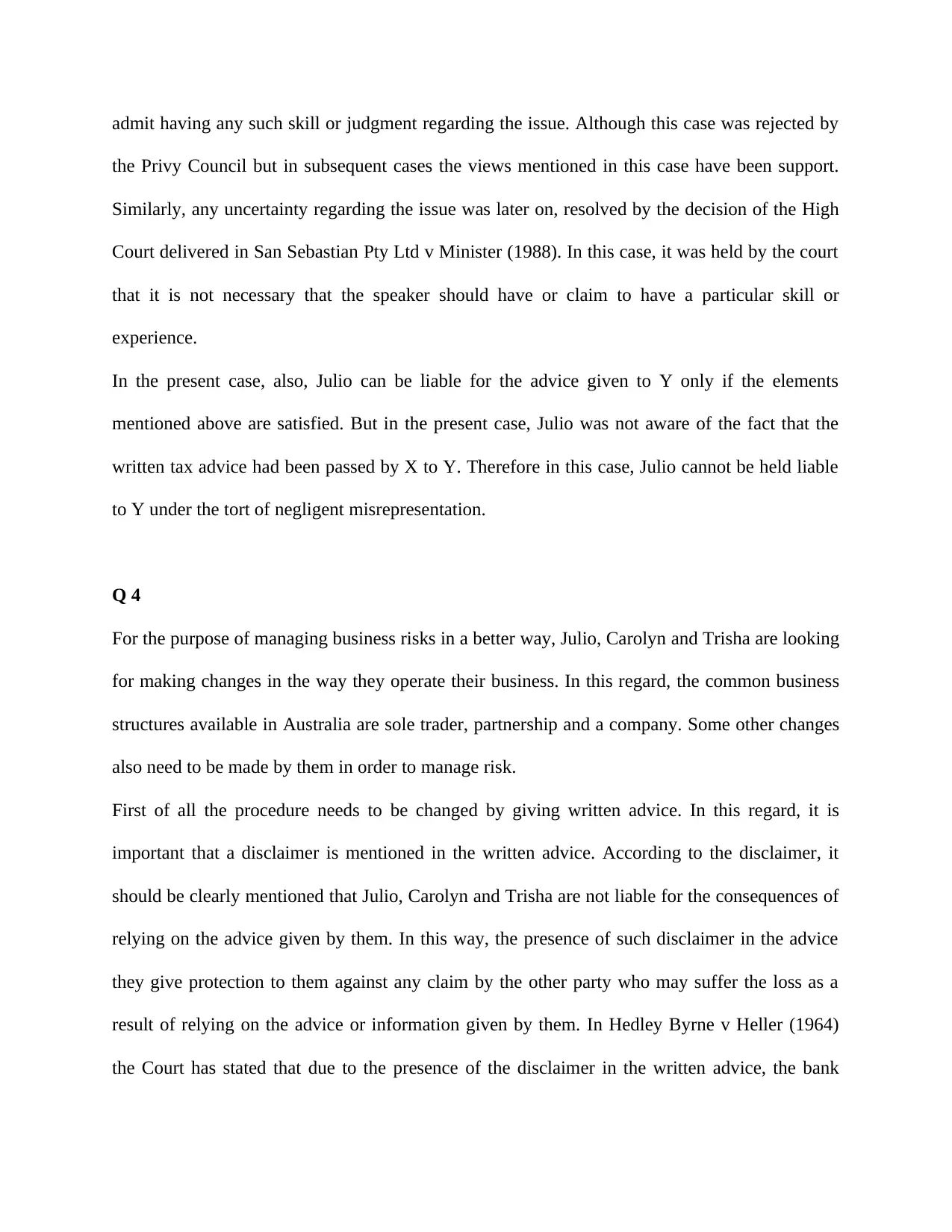
admit having any such skill or judgment regarding the issue. Although this case was rejected by
the Privy Council but in subsequent cases the views mentioned in this case have been support.
Similarly, any uncertainty regarding the issue was later on, resolved by the decision of the High
Court delivered in San Sebastian Pty Ltd v Minister (1988). In this case, it was held by the court
that it is not necessary that the speaker should have or claim to have a particular skill or
experience.
In the present case, also, Julio can be liable for the advice given to Y only if the elements
mentioned above are satisfied. But in the present case, Julio was not aware of the fact that the
written tax advice had been passed by X to Y. Therefore in this case, Julio cannot be held liable
to Y under the tort of negligent misrepresentation.
Q 4
For the purpose of managing business risks in a better way, Julio, Carolyn and Trisha are looking
for making changes in the way they operate their business. In this regard, the common business
structures available in Australia are sole trader, partnership and a company. Some other changes
also need to be made by them in order to manage risk.
First of all the procedure needs to be changed by giving written advice. In this regard, it is
important that a disclaimer is mentioned in the written advice. According to the disclaimer, it
should be clearly mentioned that Julio, Carolyn and Trisha are not liable for the consequences of
relying on the advice given by them. In this way, the presence of such disclaimer in the advice
they give protection to them against any claim by the other party who may suffer the loss as a
result of relying on the advice or information given by them. In Hedley Byrne v Heller (1964)
the Court has stated that due to the presence of the disclaimer in the written advice, the bank
the Privy Council but in subsequent cases the views mentioned in this case have been support.
Similarly, any uncertainty regarding the issue was later on, resolved by the decision of the High
Court delivered in San Sebastian Pty Ltd v Minister (1988). In this case, it was held by the court
that it is not necessary that the speaker should have or claim to have a particular skill or
experience.
In the present case, also, Julio can be liable for the advice given to Y only if the elements
mentioned above are satisfied. But in the present case, Julio was not aware of the fact that the
written tax advice had been passed by X to Y. Therefore in this case, Julio cannot be held liable
to Y under the tort of negligent misrepresentation.
Q 4
For the purpose of managing business risks in a better way, Julio, Carolyn and Trisha are looking
for making changes in the way they operate their business. In this regard, the common business
structures available in Australia are sole trader, partnership and a company. Some other changes
also need to be made by them in order to manage risk.
First of all the procedure needs to be changed by giving written advice. In this regard, it is
important that a disclaimer is mentioned in the written advice. According to the disclaimer, it
should be clearly mentioned that Julio, Carolyn and Trisha are not liable for the consequences of
relying on the advice given by them. In this way, the presence of such disclaimer in the advice
they give protection to them against any claim by the other party who may suffer the loss as a
result of relying on the advice or information given by them. In Hedley Byrne v Heller (1964)
the Court has stated that due to the presence of the disclaimer in the written advice, the bank
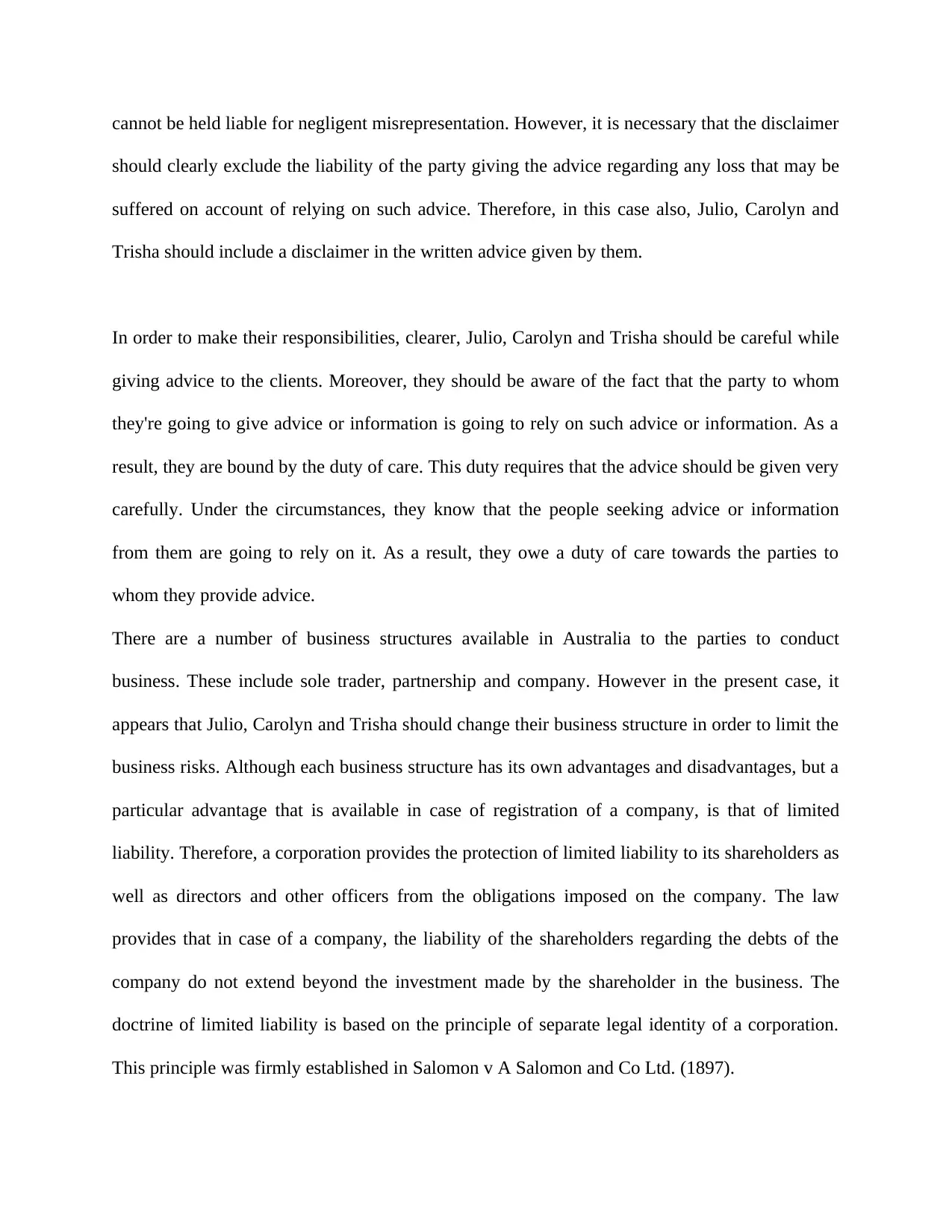
cannot be held liable for negligent misrepresentation. However, it is necessary that the disclaimer
should clearly exclude the liability of the party giving the advice regarding any loss that may be
suffered on account of relying on such advice. Therefore, in this case also, Julio, Carolyn and
Trisha should include a disclaimer in the written advice given by them.
In order to make their responsibilities, clearer, Julio, Carolyn and Trisha should be careful while
giving advice to the clients. Moreover, they should be aware of the fact that the party to whom
they're going to give advice or information is going to rely on such advice or information. As a
result, they are bound by the duty of care. This duty requires that the advice should be given very
carefully. Under the circumstances, they know that the people seeking advice or information
from them are going to rely on it. As a result, they owe a duty of care towards the parties to
whom they provide advice.
There are a number of business structures available in Australia to the parties to conduct
business. These include sole trader, partnership and company. However in the present case, it
appears that Julio, Carolyn and Trisha should change their business structure in order to limit the
business risks. Although each business structure has its own advantages and disadvantages, but a
particular advantage that is available in case of registration of a company, is that of limited
liability. Therefore, a corporation provides the protection of limited liability to its shareholders as
well as directors and other officers from the obligations imposed on the company. The law
provides that in case of a company, the liability of the shareholders regarding the debts of the
company do not extend beyond the investment made by the shareholder in the business. The
doctrine of limited liability is based on the principle of separate legal identity of a corporation.
This principle was firmly established in Salomon v A Salomon and Co Ltd. (1897).
should clearly exclude the liability of the party giving the advice regarding any loss that may be
suffered on account of relying on such advice. Therefore, in this case also, Julio, Carolyn and
Trisha should include a disclaimer in the written advice given by them.
In order to make their responsibilities, clearer, Julio, Carolyn and Trisha should be careful while
giving advice to the clients. Moreover, they should be aware of the fact that the party to whom
they're going to give advice or information is going to rely on such advice or information. As a
result, they are bound by the duty of care. This duty requires that the advice should be given very
carefully. Under the circumstances, they know that the people seeking advice or information
from them are going to rely on it. As a result, they owe a duty of care towards the parties to
whom they provide advice.
There are a number of business structures available in Australia to the parties to conduct
business. These include sole trader, partnership and company. However in the present case, it
appears that Julio, Carolyn and Trisha should change their business structure in order to limit the
business risks. Although each business structure has its own advantages and disadvantages, but a
particular advantage that is available in case of registration of a company, is that of limited
liability. Therefore, a corporation provides the protection of limited liability to its shareholders as
well as directors and other officers from the obligations imposed on the company. The law
provides that in case of a company, the liability of the shareholders regarding the debts of the
company do not extend beyond the investment made by the shareholder in the business. The
doctrine of limited liability is based on the principle of separate legal identity of a corporation.
This principle was firmly established in Salomon v A Salomon and Co Ltd. (1897).
⊘ This is a preview!⊘
Do you want full access?
Subscribe today to unlock all pages.

Trusted by 1+ million students worldwide
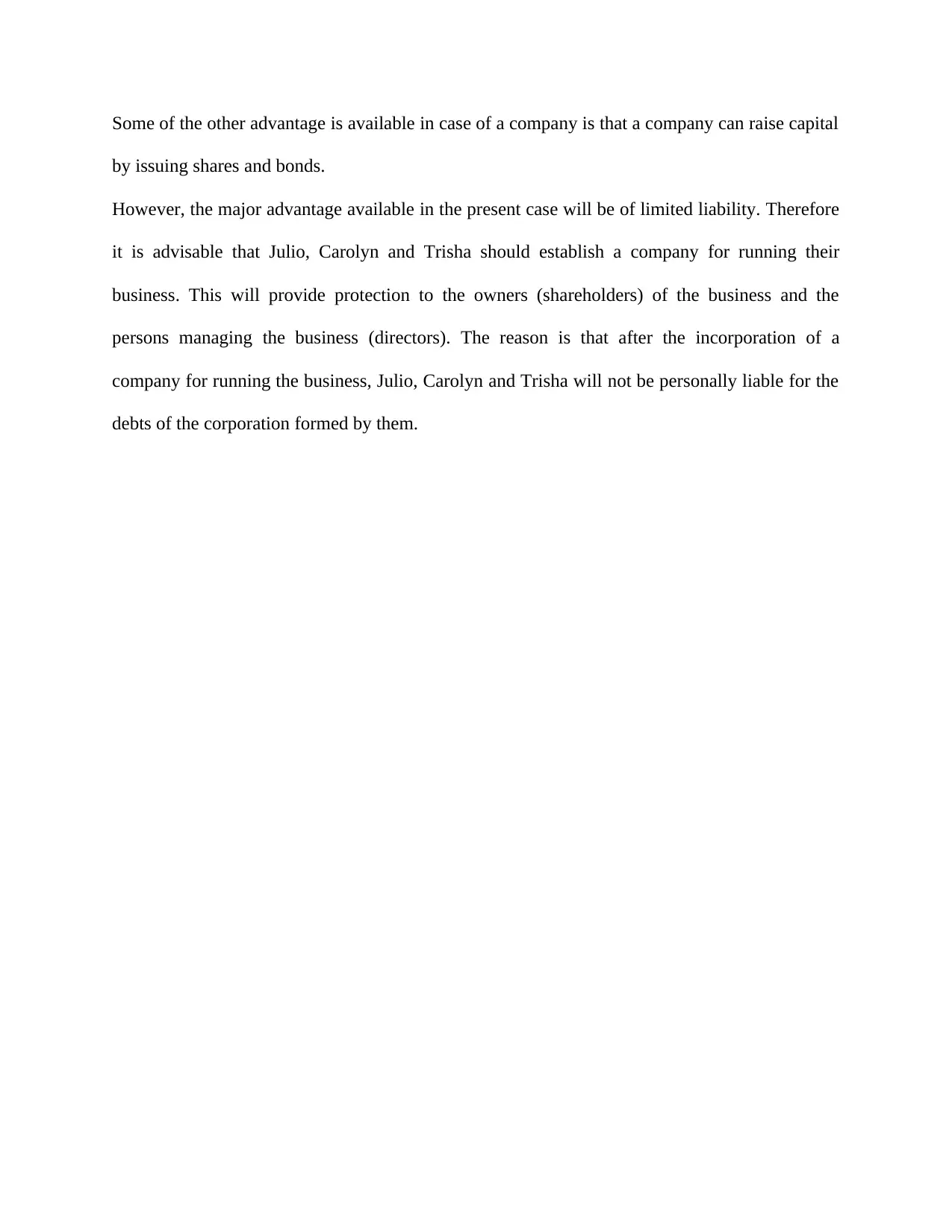
Some of the other advantage is available in case of a company is that a company can raise capital
by issuing shares and bonds.
However, the major advantage available in the present case will be of limited liability. Therefore
it is advisable that Julio, Carolyn and Trisha should establish a company for running their
business. This will provide protection to the owners (shareholders) of the business and the
persons managing the business (directors). The reason is that after the incorporation of a
company for running the business, Julio, Carolyn and Trisha will not be personally liable for the
debts of the corporation formed by them.
by issuing shares and bonds.
However, the major advantage available in the present case will be of limited liability. Therefore
it is advisable that Julio, Carolyn and Trisha should establish a company for running their
business. This will provide protection to the owners (shareholders) of the business and the
persons managing the business (directors). The reason is that after the incorporation of a
company for running the business, Julio, Carolyn and Trisha will not be personally liable for the
debts of the corporation formed by them.
1 out of 10
Related Documents
Your All-in-One AI-Powered Toolkit for Academic Success.
+13062052269
info@desklib.com
Available 24*7 on WhatsApp / Email
![[object Object]](/_next/static/media/star-bottom.7253800d.svg)
Unlock your academic potential
Copyright © 2020–2025 A2Z Services. All Rights Reserved. Developed and managed by ZUCOL.





